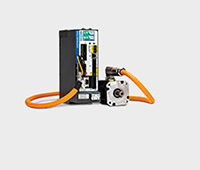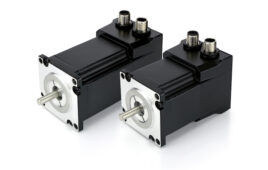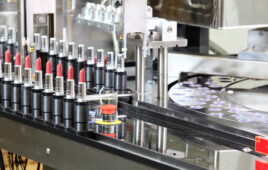Butt splices aren’t the easiest things in the world to handle. The small, circular component designed to join two ends, or butts, of two objects together without overlapping, have been known to slip through fingers when inserting a wire connector while trying to crimp it.
The process of manufacturing butt splices can be challenging as well. That’s why engineers at Sumitomo, a global company involved in a variety of industries, turned to Smart Engineering Systems, Becker Engineering, Clayton Controls and Dorner Mfg., to streamline and modernize the manufacturing process and achieve greater accuracy in the positioning of splices during production from ±0.02 in. to ±0.002 in.
Engineers looked to update their equipment and help speed up the butt splice coloring process. Sumitomo’s system for applying color to butt splices involved collecting parts into a vibratory bowl and then moving them down a linear feeder where a cylinder pushed them onto a rotating spindle. After the color was applied, the spindle was pulled away and the parts fell into a bin.
“Their old machine was kind of a make-shift deal,” said Rob Greiner, P.E., at Smart Engineering Systems. “They fed parts basically into a felt pen, and that would apply the stripes to the butt splices. It was a pretty crude system and not very efficient. So they asked us to make a machine to solve that problem.”

The Dorner 3200 Series conveyor was able to shorten drying times and increase production rates because of its numerous indexing stations.
Typical conveyors have their belts run continuously to transport parts, but this application had several specific requirements, which included the ability to index the belt in incremental steps and pallet mounting hardware that needed to be fixed at predetermined spacing on the belt, plus, the system needed to be an off-the-shelf system so that engineers didn’t have to build it from scratch.
Gerry Sakoda of Clayton Controls, an automation solution provider, was brought in to help specify and select the Dorner conveyor that would meet all these needs. Sakoda worked with Mark Becker, P.E., of Becker Engineering to provide the mechanical engineering and electronic controls for the machine, and to ensure that the conveyor met all of the mechanical requirements. Becker also supported Smart Engineering on the motor sizing and electrical interface to the conveyor controls.
Smart Engineering Systems and Becker Engineering designed the machine to greatly reduce the drying time of parts and increase production rates. Butt splices are fully dry before they are removed from the tooling mandrel. This is because the Dorner 3200 Series Precision Move Conveyor has many indexing stations available, something that is not achievable on a cam type indexer. The machine’s design also allows for brighter and more consistent colors on the butt slices; two stripes can be applied simultaneously; operator intervention is not required during the process; and production costs are lower because no felt tip markers are required.

Using a fiber optic area sensor and a stepper motor drive, engineers were able to increase the conveyors accuracy from ±0.02 in. to ±0.002 in.
The conveyor platform uses timing belt and drive technology for accurate movement of product at specific times, distances and intervals. The need for precise conveyor movement made it a good fit, as the application involves constant and precise starting and stopping of the conveyor.
“One of the reasons we used Dorner’s Precision Move is that we can place the butt splice on a fixture mount attached to the conveyor, move it over to the print section, and do an ink transfer while the part is still connected to the fixture mount,” Greiner said. “The part then travels around the distance of the conveyor for one minute, giving time for the part and the color to cure. Next, the grippers grab the part and drop it into a container.”
The conveyor was designed for applications that involve machine integration, robotic pick-n-place and precision indexing. It has an accuracy of ± 0.02 in., can carry up to 200 lb and has belt speeds up to 370 fpm. The conveyor operates at a speed of about one inch per second for Sumitomo.
Engineers devised a method for increasing the positioning accuracy of the fixture mount from ±0.02 in. to ±0.002 in. They used a fiber optic area sensor to detect the leading edge of the fixture mount as it approached the splice loading station. In conjunction with a stepper motor drive they were able to attain the increased accuracy at this one critical loading station. The mandrel on the smallest fixture mount is only 0.043 in. in diameter; so ± 0.02 in. is nearly 50% of the mandrel diameter.
Precise accuracy isn’t the only enhanced capability of the system. The combination of the new machine and conveyor has more than doubled production of colored butt splices to about 60 per minute. It also features quick-change tooling; allowing Sumitomo to change colors more efficiently. The machine is much more robust than what had been used and has more logic to help identify things that might go wrong. Another added plus is the reduced the drying time before the part ever gets touched, and that reduces smears.
Dorner Mfg.
www.dornerconveyors.com
Filed Under: Conveyors, Drives (stepper) + amplifiers, MOTION CONTROL, Motors • stepper





Tell Us What You Think!